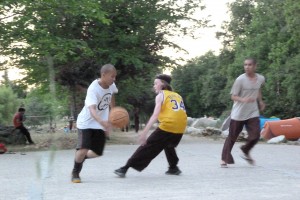One of the Plum Village practice centers is located in the eastern outskirts of Paris and called Maison de l’Inspir (meaning ‘Inspiration House’). It offers a quiet place to practice sitting meditation, attend talks, calmly walk the banks of the Marne River, enjoy a lovingly-prepared meal and relax with the community. For the past four years, a neighbor and long-time practitioner Christiane Terrier has organized increasingly popular days of mindfulness for educators called Educ’Inspir.
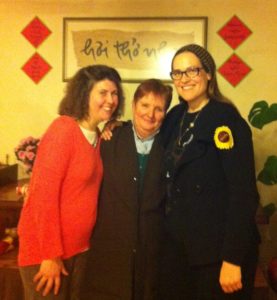
A group of volunteers from Plum Village joined 60 Parisian teachers for the most recent edition of Educ’Inspir. Christiane, a retired Chemistry and Physics teacher herself, led us through exercises and readings in her jovial teaching style. In short, we did nothing but cultivate joy and happiness for eight hours straight.
It was -12°C that Saturday morning and every teacher was grinning ear to ear. What’s Christiane’s trick? It’s simple: mindfulness. Mindfulness of feeling joy, happiness, suffering, transformation and the conditions that make all this possible.
Here are Christiane’s sixteen steps to cultivating joy and happiness in a single day:
1. “I have arrived, I am home” – guided meditation with the whole group.
I practice guided meditations with recordings and with the whole Plum Village sangha. This experience was unique. As we followed our breath, I could feel how 65-plus people transitioned from the hustle and bustle of their commute in about ten minutes. The shift was tangible.
2. Reading excerpts from Thich Nhat Hanh: “The dandelion has my smile”
Throughout the day, Christiane read aloud to transition from one exercise to the next. She chose passages from the following books (titles listed in both French and English—when available):
- “Ch. 3, Trouver le bonheur”, «La paix en soi, la paix en marche», (Peace Begins Here)
- «Enseignements sur l’amour» (Teachings on Love)
- “Ch. 8, Réaliser le bien-être”, «Le coeur des enseignements du Bouddha» (The Heart of the Buddha’s Teachings)
- «Vivre en pleine conscience. S’asseoir» (How to Sit)
- “Le pissenlit a mon sourire.”, «La sérénité de l’instant. Paix et joie à chaque pas.» (“The dandelion has my smile”, Peace is Every Step: Living Peace)
- «Instant présent instant précieux : Le bonheur… dans l’instant, tout simplement…» (Present Moment, Wonderful Moment Gift Box)
3. Two pages are not enough: List all the conditions of happiness resent right now.
I admit it. I’d read about this exercise countless times, but I’d never actually put a pen to paper to make the list. Indeed, two pages are not enough to list the obvious and the less obvious. One classic example is enjoying a “non-toothache moment”. Christiane had to interrupt our writing flow. Better yet, we all felt our happiness actually grow bigger and stronger. By bringing our attention to the infinite conditions of happiness within and around us, we felt even happier within a half hour.
4. Cultivating gratitude. Reflect and share about how a difficulty transformed into a source of happiness.
One retreatant shared, “I’m not so sure I can distinguish between happiness in gratitude. When I feel one feeling, I simultaneously feel the offer. It’s incredible.”
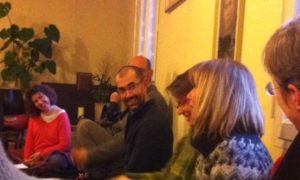
5. Smile. Guided meditation dedicated to this “practice for your mouth”.
Yes, Christiane led us through this body-centered practice. She lead us through the sensations of the upturned corners of our mouths. Sustaining the smile. Smiling at ourselves. Thanking ourselves for enjoying this peaceful moment entirely dedicated to our wellbeing. Plus, our eyes were closed so we didn’t have to worry about looking funny.
6. Choosing an inspirational card from Present Moment Wonderful Moment: 52 Inspirational Cards and a Companion Book.
Whoever wanted to chose a card and copied down a short, inspirational quote. Each of us had a special message from Thich Nhat Hanh for the day.
7. Walking meditation.
It was cold and we all recognized it. One of the participants had just learned about the death of her grandmother. She asked us to hold her grandmother in our hearts as we walked along the Marne. Walking slowly, we were able to notice the elegant black ducks and a even two grey herons. We were holding both our new friend’s sadness and the happiness of this moment together.
8. Eating meditation with dark chocolate-covered cranberries.
We had a typically q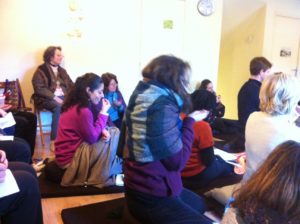 uiet lunch, Plum Village style, but Christiane treats her guests especially well and offers them a special something after lunch, too. Since this was her 15th Educ’Inspir event, she wanted to go beyond the more traditional tangerine and raisin. Eating dark chocolate-covered cranberries proved to be an advanced practice for most of us. We faced desire and craving, but also joy and laughter. This lead to the next brief exercise.
uiet lunch, Plum Village style, but Christiane treats her guests especially well and offers them a special something after lunch, too. Since this was her 15th Educ’Inspir event, she wanted to go beyond the more traditional tangerine and raisin. Eating dark chocolate-covered cranberries proved to be an advanced practice for most of us. We faced desire and craving, but also joy and laughter. This lead to the next brief exercise.
9. Telling jokes! 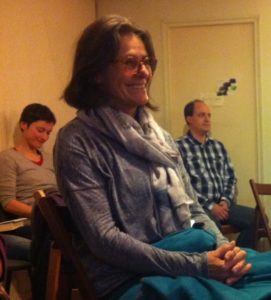
Christiane loves telling jokes. She used loving speech all the while. She also shared how she would also tell jokes to her high school students to take a joyful break in class. It proved contagious and people were glad to add to the good fun. Ten minutes of this ‘practice’ and we were bending over laughing. A little goes a long way.
Reflection: how much time do we spend cultivating joy in our daily lives? Do we need to make more room for joy and laughter in our daily lives? How?
10. Visualizing moments of happiness.
This too wasn’t as easy as it sounded. We had to recall a happy moment and relive it in our minds from A to Z. Then we shared with a partner. It felt like we were sharing our dreams. Plus it was double the fun: sharing aloud and deeply listening.
11. Nourishing beauty.
We can stop and look. See something in a new light. We can describe something for fun. We chose to “give a shape to our joy” and colored with colored pencils on paper. For those who felt like they “can’t draw”, Christiane compassionately provided photocopied pictures of butterflies that people could color and feel safe about their artistic talents.
12. No mud, no lotus. Our joy and pain are one.
We reflected on a difficulty we were able to transform into something positive. We sat with a partner. One person shared first for three minutes and the partner listened deeply. Then the listener would reflect back what she or he had heard, putting together the picture for the person who talked. No interpretation, just a summary. Then the two switched roles and repeated these two steps. In the end, each person took turns to tell their partner how they felt during this experience for one minute each. We came back together as a group and shared about how it felt to lovingly speak about a transformed difficulty and to listen to another person’s experience.
Most people were surprised to find that it felt great to feel deeply listened to by someone who was a complete stranger just a few hours earlier. We also recognized how important it is to listen to our students and help them feel deeply listened to.
13. My happiness is your happiness. We inter-are.
Christiane had photocopied the lyrics that she and her pot washing team had written one summer at Plum Village. She shared about the non-joys of pot washing a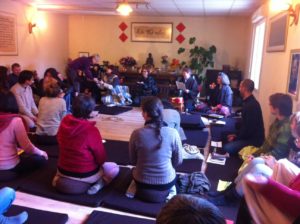 nd the joys that were born of working together with other retreatants. We all new the melody of “Au clair de la lune”, making it easy to sing along with the ironic words the pot washing family had strung together. Being supportive and being silly together seemed to boost Christiane’s unpleasant task. It was truly joyful to sing together and to add a fresh layer onto this pleasant memory.
nd the joys that were born of working together with other retreatants. We all new the melody of “Au clair de la lune”, making it easy to sing along with the ironic words the pot washing family had strung together. Being supportive and being silly together seemed to boost Christiane’s unpleasant task. It was truly joyful to sing together and to add a fresh layer onto this pleasant memory.
14. Celebrating
The last hour the floor was open to all the retreatants. Some shared their gratitude for the day we’d enjoyed together. Others shared their appreciation for Educ’Inspir’s existence and regular meetings. Some oldtimers generously shared about ways their bringing mindfulness to their classrooms. It was clear that when people had developed a strong personal practice, they eventually felt ready to share their mindfulness practice with their students. It was delightful to hear the creative ways talented teachers incorporate mindful moments in the classroom.
For example, Nathalie (who has attended three wkupS retreats this year) shared how she timidly introduced guided listening meditation to her music students. Her students began to demand more sensorial exercises to supplement the traditional exercises. She brought Hoberman Spheres and asked her students to follow their breath as they expanded the mechanism and contracted it. She’s noticed, too, that her students are growing sensitive to the emotional timbre of the music they play. With this awareness, she encourages them to know when they play sad music and when it’s time to nourish their joy and happiness, too.
15. Flower watering
Back in the pairs we made in step twelve, we watered the good seeds we recognized in our partners. It’s a lovely surprise how much we can see when we look deeply into another person’s heart and presence.
16. Ho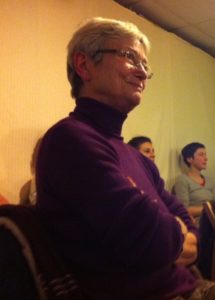 w do you feel right here and now?
w do you feel right here and now?
The feedback was unanimous: happy, joyful, recharged, inspired, appreciated, thankful.It was only natural that we broke into song with a few rounds of “Old Friends, New Friends”.
Homework
(or what Christiane gently calls “Suggestions for training back at home”):
- Everyday write down five things that made you happy.
- You can also do this with your family (at the dinner table, for example) or with your students (at the end of the lesson)
- Laugh everyday
- Give yourself the gift of listening
- After you’ve kept a gratitude or happiness journal for a while, be sure to reread it. The happiness rises like yeast!
- Enjoy reading Thich Nhat Hanh’s books or listening to recordings online. His wisdom feeds our deep joy, happiness and transformation.
Towards 6 p.m. we finished singing and said goodbye. Some stayed behind for a quiet dinner composed of French, German and Vietnamese dishes – signs of the many hands that had prepared the delicious meal. We washed our dishes and helped ourselves to tea in the common room. With mugs in hand, Sister Elizabeth shared about the community’s recent outreach to migrants camped in Calais. Members of Maison de l’Inspir went with nothing but their loving presence to offer. What they received in return, however, was identical to what we educators had experienced that during our day together: space, deep listening, smiles, time to share stories and the feeling of being part of a deeply rooted family.
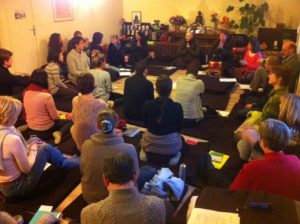
This day of mindfulness was part of a regular series at Maison de l’Inspir, Paris. Please feel free to try these exercises yourself and with educators in your work in environment or with a local mindfulness practice group for educators.

